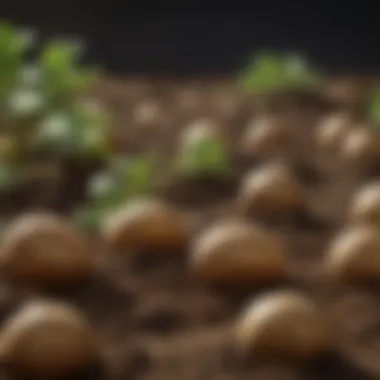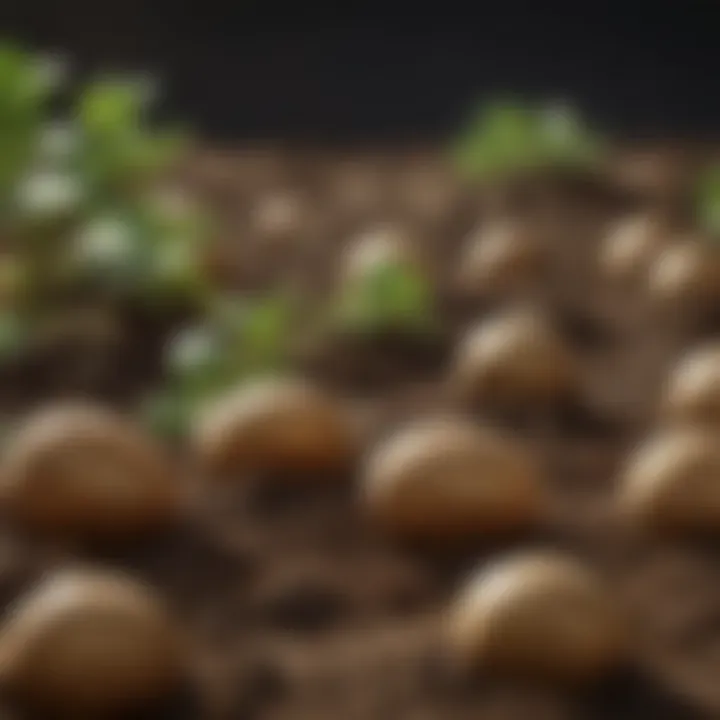Essential Fertilizers for Thriving Potato Plants


Intro
This article focuses on fertilizers specifically for potato cultivation. Potatoes are a staple food and their growth depends significantly on proper nutrition. In order to achieve optimal growth, understanding the role of fertilizers is essential. Fertilizers provide the necessary nutrients that potatoes require for healthy development, robust yield, and improved quality. This guide will explore the best practices for choosing and applying fertilizers tailored to potato needs, covering nutrient requirements, different types of fertilizers, and factors affecting their use.
Key Insights and Trends
Understanding the current trends in fertilizer use can help ensure successful potato cultivation. Soil health has become a focal point in modern gardening practices. Here are some insights:
- Emphasis on Organic Fertilizers: Organic options are becoming increasingly popular due to their environmental benefits. They improve soil structure and enhance microbial activity, which is vital for potato growth.
- Precision Agriculture: The use of technology in gardening is on the rise. Tools that analyze soil nutrient levels provide data to apply the correct fertilizers at optimal times.
- Sustainability: Many gardeners are adapting practices that not only improve yield but also maintain the health of the ecosystem.
Additionally, popular gardening techniques of the season focus on integrated pest management and crop rotation. Crop rotation specifically helps manage soil nutrients, making it easier for growers to determine the best fertilizer applications.
Nutrient Requirements of Potatoes
Potatoes require specific nutrients for healthy growth. Key nutrients include:
- Nitrogen: Important for vegetative growth and overall plant health.
- Phosphorus: Crucial for root development and tuber formation.
- Potassium: Enhances disease resistance and improves tuber quality.
These nutrients should be balanced based on soil tests to ensure potatoes thrive. Knowing the specific needs will guide the type of fertilizer chosen.
Types of Fertilizers
Selecting the right fertilizer is vital. Here are the categories:
- Organic Fertilizers
- Inorganic Fertilizers
- Compost
- Manure
- Bone meal
- Fish emulsion
- Urea
- Ammonium phosphate
- Potassium chloride
Organic options tend to improve soil health and provide slow-release nutrients. Inorganic fertilizers can provide a quick nutrient boost but should be used carefully to avoid nutrient overload.
Application Strategies
How you apply fertilizers can significantly impact their effectiveness. Here are some effective strategies:
- Soil Preparation: Before planting, integrate fertilizers into the soil to allow for even distribution.
- Top Dressing: Apply fertilizer during the growing season to provide supplementary nutrients. This is especially useful when the plant shows signs of nutrient deficiency.
- Timing: Apply fertilizers at the right growth stages. For potatoes, early feeding is critical as strong roots develop.
Closure
The Nutritional Needs of Potatoes
Understanding the nutritional needs of potatoes is crucial for achieving optimal growth and quality yields. This section delves into the essential nutrients required by potato plants, illustrating how their availability directly influences plant development and productivity. By recognizing these needs, gardeners can tailor their fertilization strategies to meet the demands of potato crops effectively.
Essential Nutrients for Potato Plants
Macronutrients Overview
Macronutrients are vital in significant quantities for plants, including potatoes. The primary macronutrients for potato growth are nitrogen, phosphorus, and potassium. Each plays a distinct role in plant health. Nitrogen promotes robust foliage and overall growth, while phosphorus is essential for root development and flower formation. On the other hand, potassium aids in water regulation and disease resistance.
These macronutrients are significant in defining the growth characteristics of potatoes. Their balanced availability can bolster yield and improve potato quality. However, over-fertilization can lead to nutrient runoff and environmental issues, making it critical to assess and apply these nutrients mindfully.
Micronutrients Importance
Micronutrients may be required in smaller amounts, but they are equally important for the successful cultivation of potatoes. Key elements include boron, copper, iron, and zinc. Each micronutrient contributes to various physiological functions that enhance growth and resistance to stress. For example, iron is essential for chlorophyll production, directly impacting photosynthesis, while zinc aids in enzyme function and hormone regulation.
These micronutrients support the overall health of potato plants, ensuring that they can partake in processes such as nutrient uptake and stress tolerance. Nevertheless, deficiencies in these elements can lead to stunted growth and decreased yields, underscoring the importance of a comprehensive nutrient management approach.
Understanding Soil Health


Testing Soil Composition
Testing soil composition is an integral step in understanding the nutritional needs of potatoes. Soil tests reveal the levels of macronutrients and micronutrients present, providing insight into which amendments are necessary. Regular testing allows gardeners to make informed decisions, ensuring that the soil environment is conducive to optimal potato growth.
This practice is beneficial as it uncovers nutrient deficiencies or surpluses, guiding the selection of suitable fertilizers. Ignoring soil testing may lead to wasteful spending on unnecessary amendments or inadequate nutrient supply, both of which can hinder potato development.
Impact of pH Levels
The pH level of soil significantly affects nutrient availability for potatoes. Ideally, soil pH should be between 5.5 and 6.5, where most nutrients are most accessible to plants. Low or high pH levels can render certain nutrients unavailable, which directly impacts potato health. For instance, at low pH, aluminum toxicity may occur, while high pH can affect iron uptake.
Maintaining an optimal pH enhances nutrient utilization and fosters a healthier growing environment, resulting in higher yields and better quality potatoes. Monitoring and adjusting soil pH is thus essential in any fertilization strategy, ensuring that potatoes can access the nutrients they need to thrive.
Types of Fertilizers for Potatoes
Understanding the types of fertilizers suitable for potatoes is crucial for optimizing their growth. Each fertilizer type offers unique benefits and can significantly influence the yield and quality of the crop. The choice of fertilizer often depends on the specific nutrient needs of potatoes, local soil conditions, and gardening practices. In this section, we will explore the benefits and considerations regarding both organic and synthetic fertilizers, along with the differences between slow-release and fast-release options.
Organic Fertilizers
Compost
Compost plays an important role in the health of potato plants. It is made from decomposed organic material such as kitchen scraps and yard waste. One key characteristic of compost is its high nutrient content, rich in essential elements like nitrogen, phosphorus, and potassium. It provides a slow, steady release of nutrients, which is beneficial for sustained plant health throughout the growing season.
The unique feature of compost lies in its ability to improve soil structure and increase moisture retention. This is crucial for potatoes, which prefer well-drained but moist soil. While compost is generally a popular choice due to its environmental benefits and versatility, it may have some disadvantages. It can be less concentrated than synthetic options and may require larger quantities to achieve desired nutrient levels.
Manure
Manure is another organic fertilizer frequently used in potato cultivation. A significant aspect of manure is its nutrient density, offering a balance of macronutrients and micronutrients beneficial for potato growth. It is a favored choice due to its availability and natural composition.
One noteworthy feature of manure is its ability to enhance microbial activity in the soil. This can lead to improved nutrient absorption and healthier plants. However, there are some concerns with using manure. It can introduce pathogens and weed seeds, requiring proper handling and processing before application. These factors should be considered carefully when selecting manure as a fertilizer.
Synthetic Fertilizers
Granular Options
Granular fertilizers are widely used for potato cultivation. They are convenient and easy to apply. One of the advantages of granular options is their ability to deliver nutrients at a controlled rate. This means that the nutrients can last longer, which is beneficial for long-term growth.
A unique characteristic of granular fertilizers is their concentrated nutrient formulation, providing immediate access to essential elements, such as nitrogen. This can be particularly useful for critical growth stages of potato plants. However, improper application can lead to nutrient runoff, which may harm the environment.
Liquid Solutions
Liquid solutions are another form of synthetic fertilizers frequently applied to potato crops. They offer quick absorption and immediate effects on plant health. The key characteristic of liquid fertilizers is their ability to address nutrient deficiencies rapidly.
Liquid solutions can be beneficial for fine-tuning nutrient applications throughout a potato's growth phases. They also provide flexibility, allowing for targeted application tailored to specific needs of the plants. However, one disadvantage is that they need to be applied more frequently compared to granular options, which might require more labor and planning.
Slow-Release vs. Fast-Release Fertilizers
Benefits of Slow-Release
Slow-release fertilizers offer several benefits for potato cultivation. They release nutrients gradually over an extended period. This characteristic reduces the risk of nutrient leaching and ensures a consistent supply of essential elements. This can translate to improved yield stability and overall plant vigor.
A unique benefit of slow-release options is their capacity to reduce the frequency of application. This not only saves time for the gardener but also minimizes the potential environmental impact from over-fertilization. However, these fertilizers may take longer to show visible results, which can be a drawback in situations requiring immediate nutrient support.
Situations for Fast-Release Use
Fast-release fertilizers are particularly useful in certain circumstances. They provide immediate nutrient access, which can be crucial during specific growth stages. For example, if potato plants show signs of nutrient stress, a fast-release fertilizer can quickly address the issue.
However, the key characteristic of fast-release fertilizers is how they can lead to rapid growth. This can be a double-edged sword, as it may make plants more susceptible to diseases or pest pressures due to their softer tissues. Additionally, the risk of nutrient burnout exists since the nutrients are available only for a short period, necessitating careful management to optimize their effectiveness.
Application Techniques
Understanding application techniques is vital for achieving optimal fertilization in potato cultivation. How and when fertilizers are applied can greatly influence the growth and yield of potato plants. Efficient techniques ensure that nutrients are accessible at the right time and in the right amounts. This section elaborates on the timing and methods of fertilizer application, which are crucial elements for any farming strategy.


Timing Fertilizer Application
Proper timing in applying fertilizers is significant as it aligns nutrient supply with the plant's growth cycle. Applying fertilizers too early or too late can lead to nutrient wastage or deficiencies. Therefore, a structured approach to timing is needed.
Pre-Planting Requirements
Pre-planting fertilizer application involves preparing the soil before planting potatoes. This action contributes to establishing a nutrient-rich environment for seed tubers. A key characteristic of pre-planting requirements is that it allows for greater nutrient availability from the start. This timing is a beneficial choice as it sets the stage for healthier growth.
A unique feature of pre-planting applications is the ability to incorporate fertilizers into the soil. This practice can enhance nutrient absorption. However, it’s essential to consider the type of fertilizer. Organic options like compost enrich the soil gradually, while synthetic options provide an immediate nutrient release, each having its advantages and disadvantages in this article.
During Growth Stages
Applying fertilizers during the growth stages is another critical aspect supporting the overall health of potato plants. This phase allows for adjustments based on observed plant needs. A key characteristic of this approach is its adaptability, making it a popular choice among experienced gardeners.
When fertilizers are applied during growth, it targets specific stages where plants require more nutrients. For instance, tuber formation is a time when potassium levels are crucial. The unique feature here is the ability to tailor applications. The downside, however, is that this requires careful monitoring and may involve multiple applications, which could become labor-intensive.
Application Methods
Choosing the right application method significantly impacts fertilizer effectiveness. Different methods can influence how well the nutrients are absorbed by potato plants. Knowing these techniques can help ensure that nutrients reach the roots efficiently.
Broadcasting Techniques
Broadcasting techniques involve spreading fertilizer evenly over a large area. This method is practical for covering vast fields effectively. A key characteristic is simplicity, which makes it an easy choice for many farmers. It’s particularly useful when using granular fertilizers.
The unique aspect of broadcasting is that it saves time and labor when large amounts are needed. However, it also has disadvantages. If not done carefully, nutrients may end up on non-target areas, leading to wastage. Moreover, some nutrients may leach away if not incorporated properly into the soil.
Banding Techniques
Banding techniques refer to placing fertilizers in bands near the plant's root zone. This method ensures that nutrients are close enough for easy uptake. A key characteristic of banding is its efficiency; it reduces the volume of fertilizer needed compared to broadcasting.
The unique feature of banding is that it minimizes competition with weeds and improves nutrient concentration around the plant. However, this method requires more precision in application and can be more labor-intensive. Despite the effort, it can result in healthier crops and improved yields.
Environmental Considerations
Impact of Climate on Fertilizer Needs
Understanding Regional Differences
Understanding regional differences is vital for effective fertilizer application in potato farming. Different regions have specific soil types, moisture levels, and climatic conditions that directly influence nutrient uptake. This understanding allows for a more tailored fertilizing strategy, maximizing the efficiency of inputs used and minimizing waste. For example, areas with sandy soils may require more frequent applications due to rapid nutrient leaching, while clay-rich soils can retain nutrients longer.
This localized approach offers benefits such as reduced costs and improved crop health. However, the challenge lies in accurately assessing local conditions, which can vary even within short distances.
Adjusting Fertilization Based on Weather
Adjusting fertilization based on weather is an integral aspect of successful potato farming. Weather conditions, such as rainfall and temperature fluctuations, impact soil moisture and subsequently nutrient availability. For instance, heavy rainfall can lead to nutrient leaching, necessitating immediate adjustments in fertilization rates. Conversely, during dry spells, fertilizers may stay in the soil longer, reducing the need for additional applications.
This adaptive method helps optimize plant nutrition while preventing over-fertilization, which can harm both crops and the environment. The downside is that it demands constant monitoring, making it resource-intensive but ultimately rewarding in terms of crop resilience.
Sustainable Practices in Potato Farming
Reducing Chemical Inputs
Reducing chemical inputs is a critical strategy in making potato farming more sustainable. This involves shifting towards organic alternatives or lower chemical concentrations to achieve the desired nutrient levels. Cutting down on synthetic fertilizers can decrease the negative environmental impacts, such as soil degradation and water pollution. This method promotes healthier soils and enhances microbial activity, which is beneficial for long-term crop productivity.
However, there can be trade-offs regarding immediate crop yields, as organic solutions often release nutrients at a slower rate. It requires careful planning and understanding of soil dynamics to ensure nutrient demands are met without heavy chemical reliance.
Integrating Cover Crops
Integrating cover crops is another sustainable practice that enhances soil health and minimizes erosion. These crops, grown in the off-season, help fix nitrogen, improve soil structure, and reduce weed pressure. Cover crops can lead to improved moisture retention and nutrient cycling, benefiting subsequent potato crops.


The unique feature of this practice is its ability to add organic matter to the soil, which improves overall fertility. Nonetheless, it can increase the complexity of farm management, requiring additional planning and knowledge about crop rotation.
Ultimately, understanding and implementing environmental considerations create a pathway towards sustainable potato production, which balances economic viability and ecological integrity.
Monitoring Plant Health
Monitoring plant health is a crucial aspect of potato cultivation. By observing the condition of the plants, one can identify any potential issues before they become severe. This process contributes significantly to maximizing yield while ensuring quality. Regular monitoring allows growers to adjust their fertilization strategies based on the plants' reactions and needs.
Identifying Nutrient Deficiencies
Symptoms of Deficient Nutrients
Identifying nutrient deficiencies in potatoes is essential for achieving optimal growth. Certain symptoms clearly indicate which nutrients are lacking. For example, yellowing leaves may suggest a nitrogen deficiency, while purple edges on leaves may indicate a need for phosphorus. Recognizing these specific symptoms helps in timely intervention.
The key characteristic of observing nutrient deficiency symptoms is the visual nature of this method. A grower can assess the condition of plants repeatedly and note changes. This method is beneficial because it requires no sophisticated technology or equipment.
One unique feature of monitoring symptoms is that it allows one to track growth over time. However, there can be disadvantages as well. Simple visual observations might sometimes lead to incorrect assumptions. For instance, similar symptoms can appear due to pests or diseases, not just nutrient deficiencies.
Corrective Actions
Taking corrective actions based on identified deficiencies is key to maintaining healthy potato plants. Once a deficiency has been identified, a grower can apply the necessary nutrients. For example, adding a nitrogen-rich fertilizer can rectify nitrogen deficiency quickly. These actions directly contribute to improving the overall vitality of the plants.
The main advantage of addressing nutrient deficiencies promptly is the potential for increased yield. Timely interventions can lead to healthier plants that produce better tubers. Moreover, this practice supports long-term soil health, ensuring nutrients remain available for future crops.
However, one must note that over-correcting can also lead to nutrient burn, causing more harm than good. Thus, it is important to apply corrective actions judiciously, after assessing the specific needs of the plants.
Adjusting Fertilizer Applications
Reassessing Soil Conditions
Reassessing soil conditions periodically is critical for effective fertilizer application. This helps in understanding if the current fertilization strategy is suitable. Soil tests can reveal nutrient levels, moisture content, and pH levels. Regular reassessment allows growers to adapt their strategies based on soil health changes.
The key characteristic of this practice is its data-driven approach. By relying on soil tests, growers can make informed decisions. This practice is beneficial since it aligns fertilizer applications more closely with actual plant needs.
A unique feature of reassessing soil conditions is the ability to prevent excess use of fertilizers, reducing environmental risks. However, it can be perceived as time-consuming and requires a certain level of expertise to interpret results correctly.
Responding to Plant Feedback
Responding to plant feedback is about observing how plants react to fertilization changes. It encompasses adjusting applications based on plant growth patterns and developed symptoms. This feedback loop is essential for tailoring fertilization to the needs of the crop.
The key characteristic here is adaptability. Growers can change their fertilization practices based on real-time observations. This responsiveness is a popular choice among gardeners seeking to optimize yields and support plant health.
One unique aspect of this method is that it builds a more dynamic farming approach. Adaptation can lead to better resource management and sustainability. However, challenges include the need for experience to interpret plant signals accurately. Misinterpretations could lead to poor decision-making, impacting the crop yield adversely.
Finale
In closing, the discussion on fertilizers for potatoes underscores the significance of a targeted approach to nutrient application. It integrates the concepts of understanding plant health, soil conditions, and environmental impact. Using proper fertilization strategies not only increases yield but also enhances the quality of the potatoes produced. This article aims to equip both new and seasoned gardeners with the necessary knowledge to make informed decisions regarding fertilizer use. It reflects an understanding that a successful harvest relies on a combination of diverse factors, including choosing the right type of fertilizer, applying it at appropriate times, and considering the characteristics of the soil and local climate.
Recap of Fertilization Strategies
The focus on fertilization strategies throughout this article highlights a holistic understanding of potato cultivation. From organic to synthetic options, knowing what to use and when is key to practicing efficient agriculture. This knowledge is essential for achieving the best results in potato farming.
Holistic Approach to Fertilizers
A holistic approach to fertilizers looks at the entire ecosystem involved in potato growth. This method emphasizes considering various elements—soil health, plant requirements, and environmental factors—when making fertility decisions. One key characteristic of this approach is its adaptability to specific conditions. It allows growers to tailor their fertilization practices to individual situations, thus enhancing overall crop performance. The unique feature here is the integration of organic methods with conventional ones. This not only addresses immediate nutrient needs but also promotes soil biology and health over time.
There are advantages to this approach, such as improving long-term plant resilience and promoting biodiversity in the soil. However, disadvantages may arise in terms of cost and the need for additional knowledge about organic practices. Balancing these factors is crucial for successful implementation.
Long-term Sustainability
Long-term sustainability in fertilizer application is another vital aspect addressed within this article. It emphasizes the significance of responsible nutrient input management, aiming to reduce environmental impacts while meeting agricultural needs. A central characteristic of this strategy is its focus on regenerative practices that enrich rather than deplete soil resources over time. By considering long-term sustainability, growers can maintain healthy soil, productive plants, and a balanced ecosystem.
This strategy is becoming increasingly popular among farmers seeking to combine productivity with ecological responsibility. The unique feature of long-term sustainability lies in integrating practices such as crop rotation, cover cropping, and reduced chemical use. These practices offer the advantage of preserving soil integrity, enhancing nutrient cycling, and fostering a more resilient agricultural system.
Nevertheless, challenges can exist, such as the initial investment in sustainable practices or the time required to see results. It requires a shift in mindset but ultimately leads to better health of the soil and plants, resulting in improved yields and quality in the long run.
In summary, the conclusion emphasizes that a comprehensive summary of fertilization strategies can lead to a greater understanding of potato cultivation. Both holistic approaches and a focus on long-term sustainability become pivotal in achieving desired outcomes while fostering environmental stewardship.



